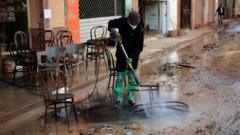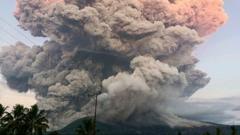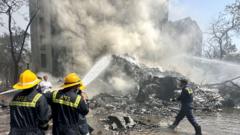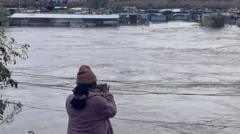With a recent bout of flooding still fresh in memory, Spain is on high alert for heavy rain and severe weather conditions.
Spain Prepares for Heavy Rainfall as New Weather System Approaches

Spain Prepares for Heavy Rainfall as New Weather System Approaches
Regions along the Mediterranean coast face orange alerts as they brace for potential storms.
Spain is bracing itself as a new weather system approaches, threatening torrential rain and cooler temperatures across the country. Just two weeks following devastating flash floods that struck eastern Spain, the meteorological agency Aemet has issued orange alerts for the eastern and southern Mediterranean regions. Key areas including Valencia, Catalonia, and Andalusia, along with the Balearic Islands, will remain on alert until Thursday.
Aemet has warned of possible strong to torrential downpours, emphasizing that the orange alert is the second highest warning level denoting significant risks to everyday activities. Authorities are actively engaging with the public—military vehicles are traversing towns via megaphones, alerting residents of the impending storms. Preventative measures are already in place, particularly in Valencia, where classes and sports activities have been called off in several towns, and sandbags are being deployed in Aldaia to protect against flooding.
Although this new “Dana” weather system won’t be as catastrophic as the previous event on October 29—which ended with 222 confirmed fatalities and 23 individuals still missing—it nevertheless poses a substantial threat. “Dana” systems occur when areas of low pressure become cut off from the jet stream, leading to prolonged rainfall in one area. This phenomenon occurs frequently in Spain, averaging 10 to 20 times a year in the western Mediterranean.
Flooding has already impacted parts of Almería province this week, with emergency responders rescuing three individuals whose vehicles were swept away. With the weather agency advising caution around ravines and waterways, the national traffic office is urging residents to check road conditions before hitting the road.
King Felipe VI was expected to visit the military base in Bétera, Valencia, where armed forces are assisting with ongoing search and recovery efforts. This follows a tumultuous visit from the king, Prime Minister Pedro Sánchez, and regional president Carlos Mazón to Valencia after the last floods, where they faced public ire and accusations regarding the lack of adequate response during the disaster.
The latest weather system, while serious, is not anticipated to reach the extremes seen just weeks prior. However, areas around Malaga and Granada could receive an estimated 180mm of rain—the equivalent of nearly two months of typical precipitation—in a matter of days, with additional hazards including large hail and gusty winds anticipated.
Simultaneously, snowfall is expected to affect the Cantabrian mountains and other major mountain chains as colder air moves across the Peninsula, further complicating the situation. The country, still healing from the recent tragedy, remains vigilant as it faces another round of potentially dangerous weather.
Aemet has warned of possible strong to torrential downpours, emphasizing that the orange alert is the second highest warning level denoting significant risks to everyday activities. Authorities are actively engaging with the public—military vehicles are traversing towns via megaphones, alerting residents of the impending storms. Preventative measures are already in place, particularly in Valencia, where classes and sports activities have been called off in several towns, and sandbags are being deployed in Aldaia to protect against flooding.
Although this new “Dana” weather system won’t be as catastrophic as the previous event on October 29—which ended with 222 confirmed fatalities and 23 individuals still missing—it nevertheless poses a substantial threat. “Dana” systems occur when areas of low pressure become cut off from the jet stream, leading to prolonged rainfall in one area. This phenomenon occurs frequently in Spain, averaging 10 to 20 times a year in the western Mediterranean.
Flooding has already impacted parts of Almería province this week, with emergency responders rescuing three individuals whose vehicles were swept away. With the weather agency advising caution around ravines and waterways, the national traffic office is urging residents to check road conditions before hitting the road.
King Felipe VI was expected to visit the military base in Bétera, Valencia, where armed forces are assisting with ongoing search and recovery efforts. This follows a tumultuous visit from the king, Prime Minister Pedro Sánchez, and regional president Carlos Mazón to Valencia after the last floods, where they faced public ire and accusations regarding the lack of adequate response during the disaster.
The latest weather system, while serious, is not anticipated to reach the extremes seen just weeks prior. However, areas around Malaga and Granada could receive an estimated 180mm of rain—the equivalent of nearly two months of typical precipitation—in a matter of days, with additional hazards including large hail and gusty winds anticipated.
Simultaneously, snowfall is expected to affect the Cantabrian mountains and other major mountain chains as colder air moves across the Peninsula, further complicating the situation. The country, still healing from the recent tragedy, remains vigilant as it faces another round of potentially dangerous weather.





















